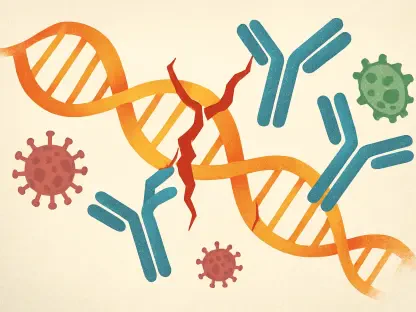In a recent pivotal study published in Nature Communications, scientists have made significant strides in understanding the genetic underpinnings of testicular cancer, offering profound insights into its development and unveiling potential treatment strategies. This comprehensive research aims to chart the genetic alterations and evolutionary pathways involved in the progression of testicular germ cell tumors (TGCTs). Testicular cancer, which accounts for about 1% of all cancers in men, has become the most common cancer in males aged 15 to 44. Annually, approximately 200 men in Ireland are diagnosed, with the incidence rates rising in Northern and Central Europe. Early detection ensures a high treatability rate, boasting survival rates exceeding 90%. However, those diagnosed with the highest-risk disease face a starkly lower prognosis, with survival rates plummeting to around 50%. These patients endure considerable toxicities and side effects from the current chemotherapy treatments, underscoring the urgent need for improved therapeutic approaches.
Leveraging Whole Genome Sequencing
Leveraging whole genome sequencing (WGS) data from the 100,000 Genomes Project spearheaded by Genomics England and NHS England, the research team conducted analyses on samples from 60 patients. This pioneering study distinguishes itself as one of the first relatively large-scale investigations employing whole genome sequencing in the context of TGCTs. Through this cutting-edge approach, the team uncovered insights that other methodologies might not have revealed. Among the key findings was the identification of new potential cancer drivers specific to certain subtypes of testicular cancer, presenting promising opportunities for stratifying patients based on their tumor characteristics. This stratification could lead to more effective and tailored treatment strategies. Additionally, researchers reconstructed the evolutionary pathways of genome alterations and predicted progression trajectories in TGCTs. Such reconstructions provide a deeper understanding of how these tumors develop and progress over time, paving the way for innovative therapeutic interventions.
The significance of whole genome sequencing in this study cannot be overstated. By utilizing WGS, researchers can obtain a comprehensive picture of genetic alterations and variability that contribute to TGCTs. The application of this technology has enabled the discovery of critical genetic components linked to cancer development that other methods might have missed. The study’s success demonstrates the potential of integrating genomics into cancer research, highlighting the pivotal role such detailed genetic mapping can play in better understanding disease mechanisms and advancing clinical outcomes. This research emphasizes the necessity for continued exploration and adoption of WGS in oncological studies, promising a future where patient treatment becomes increasingly precise and personalized based on genetic profiles.
Uncovering Mutational Signatures
One of the most pivotal findings of this research was uncovering a broader array of mutational signatures associated with TGCTs. Mutational signatures are distinctive patterns of DNA damage indicative of various carcinogenic exposures, such as smoking or UV light. By identifying these signatures, researchers can retrospectively assess cancer risk related to specific exposures, providing invaluable information for risk management and prevention strategies. This study also revealed previously unidentified recurrent mutational hotspots in testicular cancer that could serve as new focal points for research and therapeutic development. These recurrent hotspots represent consistent sites of mutation across multiple patients, offering potential targets for developing more focused and effective treatments.
In addition to mutational signatures, the study uncovered a particularly novel genomic immune mechanism unique to testicular cancer, primarily observed in seminomas, the most common tumor subtype. This finding hints at new avenues for immunotherapy approaches tailored specifically to the immune landscape of TGCTs. As immunotherapy has revolutionized treatment for various cancers, understanding the unique immune environment within testicular cancer opens the door for developing specialized immune-based therapies. These revelations underscore the importance of examining the genetic and immunological context of tumors to design better-targeted and more effective treatments.
Collaborative Efforts and Data Collection
The success of this groundbreaking study can be attributed to the extensive collaborative efforts and meticulous data collection involved. Numerous researchers, clinicians, and trainees from leading institutions, including Trinity College Dublin, the University of Oxford, the University of Cambridge, and the University of Manchester, contributed to the research. The participation of medical professionals within the NHS was crucial in obtaining valuable tissue samples from participants in the 100,000 Genomes Project. This collaboration underscores the importance of comprehensive, large-scale data collection in achieving such significant breakthroughs. By pooling expertise and resources, the research team was able to delve deeply into the genetic landscape of TGCTs, producing results that have far-reaching implications for cancer treatment and research.
Beyond uncovering new genetic drivers and mutational patterns, the study emphasizes the significance of genomic landscape studies in understanding and combating testicular cancer. The detailed genetic mapping provided by this research not only enhances our comprehension of TGCT development but also paves the way for more personalized and effective treatment strategies. Such advancements could significantly improve patient outcomes, especially for those with high-risk disease types. The study serves as a powerful reminder of the value of collaborative research efforts and the critical role large-scale data collection plays in advancing our understanding of complex diseases.
Future Directions and Broader Implications
In a groundbreaking study featured in Nature Communications, researchers have made remarkable progress in comprehending the genetic foundations of testicular cancer. This research provides new insights into its development and reveals potential treatment strategies. The study aims to map out the genetic changes and evolutionary paths associated with the growth of testicular germ cell tumors (TGCTs). Testicular cancer, making up around 1% of all male cancers, is the most prevalent cancer among men aged 15 to 44. Each year, about 200 men in Ireland receive this diagnosis, and the occurrence rates are increasing in Northern and Central Europe. Early detection leads to a high treatability rate, with survival rates over 90%. Nonetheless, those with high-risk disease experience a drastically lower prognosis, with survival rates dropping to nearly 50%. These patients suffer significant toxicities and side effects from current chemotherapy treatments, emphasizing the pressing need for better therapeutic options.









